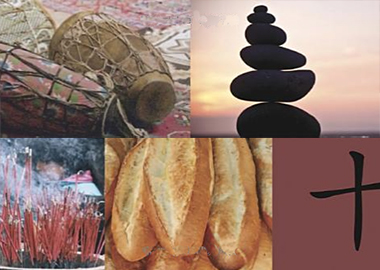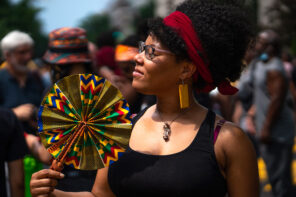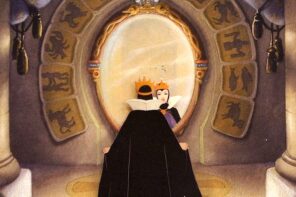First, a spoiler alert of sorts: the “half” in S. Brent Plate’s latest book is us. That is, the seeking, incomplete human body. Plate, a longtime RD writer and Visiting Associate Professor of Religious Studies at Hamilton College, contends that religion is a physical activity, the spiritual experienced through our senses. And each of those five other objects—stones, incense, drums, crosses, and bread—have a sensory component. (You can read an adapted excerpt from the book at Killing the Buddha.)
That’s not to say that each object has just one religious function or interpretation. Stones mark graves and also become tools of mass communication. Incense makes a space holy, but its value is in its disappearance. Drums can call individuals into trance states, or communities into worship. The symbol of two crossed lines is both a memorial to death, and a celebration of possibility in traditions from China to Egypt to Ethiopia. Bread is ritually important in a Judeo-Christian context, but not in Asian religious traditions; and its non-universality, writes Plate, makes bread like religion: “It has some basic ingredients…and serves certain purposes…but when we get down to the nitty-gritty of it, the similarities between traditions can be difficult to sniff out.”
Telling the history of religion through objects rather than beliefs offers an interesting corrective to a lot of the ways we hear religion discussed in public discourse. I sat down with Plate to find out more about what he wanted to accomplish.
I’m curious about the composition of the objects…did you audition other choices for these five?
The most obvious other object would have been a circle, which appears in religions around the world. But ultimately I went with the cross because it actually offered more of that contrast, the conflict, the sort of Christian vs. anti-Semitic dimension with the swastika. I couldn’t find a whole lot of controversy over a circle. People haven’t generally been labeled with a circle and said you’re the circle people. Maybe it’s out there, but it’s not very obvious!
Why is it so important to begin looking at religion from a sensual perspective? What are some of the benefits?
It’s meant to be democratic: if we’ve all got the senses, then we’ve all got access to the sacred. We taste the bread, we smell the incense; you don’t have to have an advanced degree to know what that smells like, to have a memory, or to taste that. So let’s just rethink that and say, hey that’s valuable, that’s a valuable experience. I don’t have to put that down lower because I don’t understand the theological concepts; this is actually pretty important. Don’t feel bad about having an experience involving stained glass windows; that’s not a trivial thing. People apologize for that.
They do. As you say, we often think of the intellectual as “higher” and the earthly as “lower”; to bring something down to earth is to crush it. Your conception has a different directionality to it. Human religious behavior isn’t divided into “higher” intellect and “lower” practice; it’s about reaching outward, outside of the self, through these objects.
I think that’s right, it is outward-focused, so it’s not sort of this spirituality that finds everything within oneself. It’s not against that, it’s just that you need to look outside, and see what you’re sensing, and that’s a good thing.
How does the experiential view of religion fare in the academy?
My gripe about the academy is that they do talk about these concrete forms of religion, but in very abstract ways. So this book is an experiment in translating those ideas and reframing them into great stories. While writing the book I thought about scholars and the academic study of religion, but I also thought about the spirituality and self-help section at Barnes & Noble, the interfaith world, and poets.
And that’s one of the aspects of the book I really enjoyed, the different disciplines that you draw from, that we’re not used to reading about in the study of religion. Plato is there, there’s some Augustine floating around, but you focus mostly on the practices of people.
I don’t want to say thinkers like that are wrong or bad somehow, it’s just they’re not everything. “Church history,” as I learned it, is not really just about a bunch of people who thought deep thoughts. That’s not really what church history is; that’s an intellectual history that’s interesting, but it’s not actually “church history.”
You construe examples of these practices from the broadest possible range of religious and cultural traditions, and yet manage to avoid universalism. You write that we can say all religions are the same “only if we remain in abstraction.”
That was a major concern. Actually when I lecture about the book probably 50, 60 percent of the talk is on the similarities, and then I’m very clear about saying these things are also divisive: drums divide people, incense divides people, crosses divide people. It’s very explicit. And then at the end of my talk people are always saying, “Well how come you’re only seeing similarities?” And it’s this curious thing. I began to realize we’re trained to see similarities, and seeing distinctions actually may be more difficult.
And then there are those religious traditions, especially common in Protestant America, where people don’t think they have any connection to objects at all.
I get that a lot. I just had a Quaker ask me the other day, “Well, what about us Quakers? We don’t deal with objects and the senses.” And I was like, “Of course you do: you meet in a building, the entire place is constructed for you to have a specific experience, the way you sit, the way you face each other, the way you talk about going inside to ‘greet the light.’” I mean it’s all a fully sensual thing. Just because you’re not looking at a picture of Jesus doesn’t mean you don’t need your body. Even deciding not to have incense is a sensual decision.
I was happy to see you working against the search for origins, for authentic beginnings. When it comes to the widespread symbolism of two crossed lines, you write that you “do not believe there is a singular, original cross from which all these traditions derive their cultural meaning.” The appeal of authentic beginnings is something I often find myself having to reconcile in my own work (about people who search for the Garden of Eden). Everyone wants you to have the answer.
Right, like the quest for the Garden of Eden, what’s fascinating is the stories that come out of it, it’s not like somebody’s got the right answer…that’s not the interesting thing. The process I think of taking that apart and looking at all these stories becomes so much more important, and part of our role as researchers is to say “look, that’s asking the wrong question, that’s not important, it doesn’t matter if Adam and Eve actually existed, there’s so much more to the story than just whether these two naked people were in the Garden. It’s just a fascinating story.
I tell my students that all the time, like “Who cares? Every one of you is Adam or Eve, right now! You’re in the garden of earthly delights, and you just keep eating the fruit!” Just to get them thinking about it. “Sit there for two minutes and think about when you ate the fruit last.” They go, “Oh yeah, okay, I guess I understand that. I don’t make them tell me what they did!
Is there like a dream you have for how this object-centered history of religion would manifest itself in the world; do you have ambitions or visions for that?
I’m involved with an interfaith group up in Utica, where we have huge immigrant populations, and we had a Thanksgiving service that was about bread. Everybody brought bread from their background, and we all sat around and talked about bread for half an hour: here’s my mother’s recipe, here’s the kind of things we used back home in Bosnia, or back home in Burma. You don’t have to feel like I’m gonna get it right or wrong, I’m going say something bad about God, I’m gonna say something bad about Jesus. It allows a kind of personal basis for conversation. That would be a dream for this kind of work, to help foster a different kind of interreligious dialogue. I don’t know if it will, but it would be fun.
You write that throughout history, religious reformers tend to believe that too much ritual, or too close a connection with objects, fosters the wrong kind of spirituality. I think about the prohibition of icons as sort of a political thing. An image, a ritual object—or a location of the Garden of Eden—is not something a religious institution can control.
It comes back to what we were talking about earlier, that sort of democracy of the senses. It’s always a challenge to authority when the images or the smells or the touches become prominent. I think that becomes the stuff of the people. The people own the sacred. And so the theologians and those in charge have to come along and create the structure to say, “Well, ok, I guess we’ll let that [use of music, or wine, or imagery] slide, but here’s a few guidelines for how to properly do it.” So it’s always the practice preceding the doctrine.
That’s a big reversal, we never think about it that way.
It’s the same thing with the incense. There are early theologians like Origen who say “No, incense is bad, that’s what the pagans use.” But obviously they had to say it because people were using incense. I mean, you don’t issue a prohibition of something that no one’s doing. And then after the fact you have to make the rules.
You could probably find that alternate church history you were looking for that way: “Things that have been banned” gives you information about those practices.
Right, and then how does what was once banned find its way back in? The early Christian church was trying to distinguish itself from the pagans and the Jews, so it bans incense, and then it really takes Constantine who says “Hey, here’s some censers, here’s some beautiful things to burn,” and then they seem to just be okay with it! Until of course the Protestants come along and they say “oh no, that was a mistake, let’s get back to the original thinking.”
But even there—I’ve talked about this book at seminaries, and there’s clergy in the audience. I think there’s this real desire for that kind of experience, especially among mainline Protestants, who have learned how to de-sensualize their faith. They are sort of asking, “Perhaps society isn’t going the right way? Nobody’s coming to our churches anymore. I don’t understand it.”
That’s sad.
My friend is the pastor of this Presbyterian church down the street from me, and this was the foundational church of the village where I live. It’s been there over two hundred years. It’s this enormous place that can sit about 400 people, and now there’s just 20 white-haired people sitting there. The pastor’s great, he knows this is the way it’s going, there’s probably not a lot to be done about it in a village of 2,000 people.
But he told me that sometimes at night when there’s nobody else there, he takes a piece of incense, and he lights it, and he walks around to the spots where he knows people used to sit, and who have died, and he remembers them. He goes from seat to seat and he prays for these people. And it was so moving to just think about that: the space makes the people real, and the incense too. It’s this very physical and sensual engagement that’s about people, and communities, and memory. It was very un-Presbyterian of him to do that.
But very human.
But very human! Exactly.





